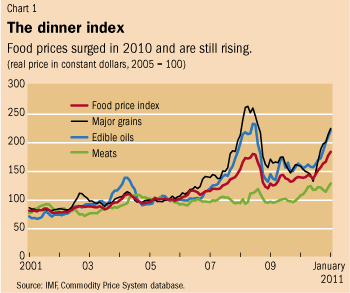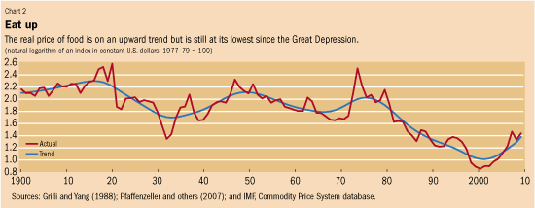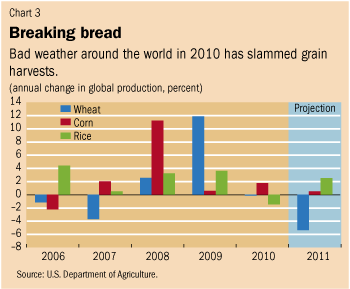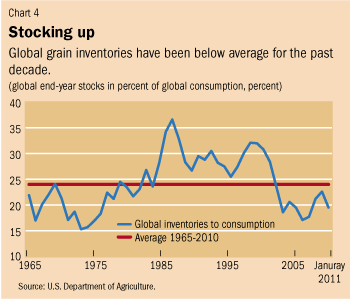Rising Prices on the Menu
Finance & Development, March 2011, Vol. 48, No. 1
Thomas Helbling and Shaun Roache
Higher food prices may be here to stay
AROUND the world, poor weather has reduced harvests and driven up food prices, fueling inflation risks and hitting the most vulnerable. Floods in Australia, Pakistan, and parts of India have helped push up the cost of food, as have droughts in China, Argentina, and Eastern Europe. Energy prices are again on the rise, with likely knock-on effects for food.
Tracking food
The IMF food price index tracks the spot prices of the 22 most commonly internationally traded agricultural food items. These include major grains—wheat, rice, and corn; oil seeds—soybeans; edible oils—palm oil; basic meats—beef carcasses; some basic seafood items—fish meal; some tropical fruits—bananas; and sugar. The index was created to facilitate assessment of food market developments and prospects for the IMF’s World Economic Outlook. The commodities it follows are those with the largest shares in international trade, and those shares determine the weight of each commodity in the index. These items generally have an international reference price—for example, the price of U.S. corn exports at gulf of Mexico ports.
Many countries—especially developing and emerging economies—are struggling with the implications of high food prices, given their effects on poverty, inflation, and, for importing countries, the balance of payments. Higher food prices may also have contributed to social unrest in the Middle East and North Africa.
International food prices were broadly stable through the first half of 2010, but they surged in the second half of 2010, and have continued rising in 2011 (see Chart 1). The IMF’s food price index (see box) is now close to the previous spike in June 2008.

The increase in food prices is, of course, bad news for all consumers. But the poor—as well as consumers in developing and emerging economies in general—are hit harder by higher food costs because food represents a much larger share of their overall spending (IMF, 2011). At the same time, rapidly rising food prices pose important macroeconomic policy challenges for decision makers in emerging and developing economies.
International food markets
Food, more than perhaps any other product, is laden with both symbolic and practical value. Concerns about food security, sufficient domestic production, and relative incomes in agriculture mean that food is not traded as readily as manufactured goods, because of protectionist agricultural policies. Despite these trade barriers, some major food items—especially major grains and oilseeds—are traded internationally. In this article we focus on the international prices of such products. Much food is not traded, so international food prices are only one determinant of domestic food inflation.

The world grew accustomed to relatively low international food prices in the 1980s and the 1990s, when prices adjusted for inflation were below those recorded during the Great Depression (see Chart 2). But since the turn of the century, food prices have been rising steadily—except for declines during the global financial crisis in late 2008 and early 2009— and this suggests that these increases are a trend and don’t just reflect temporary factors.
Expensive tastes
Perhaps the most important explanation for the trend increase in food prices is that consumers in emerging and developing economies are becoming richer and changing their diet as a result. In particular, consumers in these economies are eating more high-protein foods such as meat, dairy products, edible oils, fruits and vegetables, and seafood. These products are more “income elastic” than staple grains. In other words, as people get richer, they demand more of these high-protein foods, whereas their consumption of grains may grow more slowly or even decline.
This increases the demand for scarce agricultural resources—for example, more land might be devoted to cattle grazing instead of crop planting, while more crops are used for animal feed. Reflecting these changes, emerging and developing economies have accounted for about three-quarters of the total growth in global demand for major crops since the early 2000s.
Food and fuel
Another influence on the markets for food products over the past decade has been the boom in biofuels. High oil prices and policy support have boosted demand for biofuels, which are used as supplements in transportation fuels, particularly in the advanced economies and also in some emerging economies, including Brazil. This demand, in turn, has buoyed the demand for feedstock crops. In 2010, for example, the production of corn-based ethanol absorbed some 15 percent of the global corn crop. Other crops whose demand is correlated with that of biofuels are cane sugar, palm kernels, and rapeseed.
In addition to these indirect effects, high oil prices also have a direct effect on the cost of producing food because fuel—including natural gas—is used to produce inputs, such as fertilizers. Fuel is also used in all stages of the agricultural production cycle—from sowing to harvesting to distribution. Food prices are partly dependent on oil prices, and biofuels have likely strengthened this link.
Yielding crops
With the structural increases in the demand for many crops and other foods, prices can only remain stable over the medium term if there is a matching structural increase in supply. In other words, average prices have to increase to provide the incentives for increased supply. While farmers have responded to the opportunities from rising demand, their response has only been gradual. The interplay between productivity and acreage growth is key to understanding the supply response. Traditionally, rapid productivity growth in agriculture helped drive down food prices. But over the past decade, global productivity growth—as measured by the amount of crop produced per hectare—has fallen for rice and wheat compared with the 1980s and 1990s and has been broadly stagnant for corn and soybeans. Less productivity growth means higher prices, everything else being equal.
With lower yield growth, production increases have had to be achieved by using more land. But increasing the amount of land devoted to producing more of a crop comes at a cost, which is reflected in higher prices. The higher cost is due to two main factors.
First, crops compete for land. Since there are geographical limits to where crops can be produced, higher acreage for one crop often means lower acreage for another. Farmers decide what to plant depending on crops’ relative prices. Second, because demand for many crops has been rising at the same time, overall acreage also had to increase. To encourage farmers to plant and harvest more acreage, particularly on marginal land that is less productive, crop prices need to rise.
From a longer-term perspective, the recent decline in yield growth is worrying. It means that continued growth in demand for food will require further increases in acreage. But some of the additional land will be less productive than that now being used, whether due to lack of irrigation in arid areas, poor infrastructure, or simply lower soil fertility. In areas with rapid urbanization, fertile land is being used for purposes other than agriculture. And soil degradation and climate change have hampered yield growth.
Low yield growth and limited land availability amid rapid demand growth in an economy can lead to shifts in international trade patterns. In China, for example, rising demand for animal feed has turned that country into a net importer of corn and soybeans. Because international food markets are still relatively shallow—that is, only a small share of global production is exported, as most production is consumed locally—such developments can have large effects on world prices.
Weathering production cuts
The ongoing structural change in international food markets is clearly one factor behind the trend increase in food prices. But trends usually don’t result in abrupt price movements. To really understand recent price surges, we have to look at other factors. Indeed, the catalyst of the food price surge since mid-2010 has been a series of weather-related supply shocks. The sequence of events is well known by now.

First, drought and wildfires caused a decline in wheat production in Russia, Ukraine, and Kazakhstan. As a result, the global wheat harvest for the current crop year is now estimated to have declined by over 5 percent (see Chart 3). Then, a hot and wet summer led to a lower-than-expected corn harvest in the United States. Finally, starting in fall 2010, one of the strongest La Niña weather episodes in the past 50 years began to hit harvests—including rice—in Asia. The damage to harvests in Asia not only caused rises in the price of international food commodities but also affected local food markets, notably through the negative impact on local fruit and vegetable production.
The global price response to a supply shortfall depends not only on the size of the shortfall but also on other factors. One amplifying factor was the imposition of grain export restrictions in Russia and Ukraine. This helps to keep domestic prices low and stable but leads to higher world prices. A pattern of protectionist trade policy responses to supply shocks have also been observed during past price surges for food commodities, including in the 1973–74 and the 2006–08 booms (see Martin and Anderson, 2011).
Stocking up
Food prices are also affected by the level of stocks. Many of the major food commodities—as opposed to perishable food—are storable and, when there are harvest shortfalls, stocks can add to supply. The lower stocks are relative to consumption—the so-called stock-use ratio—the more reluctant inventory holders will be to release parts of their stocks at any given price, assuming they are maintaining them partly to protect against future shortages. So the effect of supply shocks on prices goes up as stock-use ratios fall.

Low stock-use ratios have amplified the effects on prices of recent supply disappointments and have contributed to an uptick in food price volatility. Stock levels relative to consumption decreased substantially over the past decade. At the previous food price peak in 2008, they had reached a low comparable to that recorded during the 1973–74 commodity and food price boom (see Chart 4). Favorable harvest outcomes in the second half of 2008 and early 2009 allowed for only minor rebuilding of stocks. So when supply shocks started to hit in mid-2010, food markets were still vulnerable.
The effects of supply shocks tend to be short lived. Crop production usually returns to trend quickly as weather normalizes. Indeed, periods with production shortfalls and large price spikes are usually bracketed by long periods of relative price stability (Deaton and Laroque, 1992, among others, have emphasized this pattern). In the absence of further weather disturbances, the recent food price surge can be expected to ease when the new Northern Hemisphere crop season begins later this year. But the upward trend in prices is unlikely to reverse soon because the supply adjustment to the structural increases in demand for major food commodities will take time.
Impact
The surge in international food prices has already caused higher domestic food inflation and headline consumer price inflation as of early 2011 in many economies. Such direct effects are referred to as “first-round,” and are part of the normal pass-through of prices. As in 2007–08, these effects have been greater in emerging and developing economies, where the share of food items in the consumer basket is higher than in advanced economies (IMF, 2008).
Just as poorer countries and households spend a higher proportion of their budget on food, so too the actual cost of food makes up a larger proportion of the cost of food products in poor countries than in rich countries, where the cost of labor, transportation, marketing, and packaging add value that are not in the form of calories.
But if international food prices stabilize, the first-round effects fade unless underlying, or core, inflation is affected. Economists call these indirect or “second-round” effects and they occur if the food price increases affected expectations of future inflation. If people expect food to continue to go up in price, they begin to demand higher wages, leading to increased core inflation.
The experience of the past two decades has been that risks of a pass-through from rising food prices to core inflation are low for advanced economies, but are significant for emerging and developing economies.
The main reasons for this difference are twofold (IMF, 2008). First, with the much larger expenditure shares for food and larger cost shares of raw food in the latter group of countries, food price spikes are more likely to unhinge inflation expectations and trigger increases in wage demands. Second, monetary policy credibility in emerging and developing economies remains lower despite recent improvements, implying that economic actors will be less confident in a strong central bank response to emerging inflation pressures and will thus be more likely to adjust their medium-term inflation expectations.
The IMF has traditionally advised countries to accommodate the first-round, direct effects of rising commodity prices on inflation, but to be prepared to tighten monetary policy to avoid second-round effects. At the same time, such policies have to be complemented by measures that strengthen social safety nets and protect the poor from the ravages of rising grocery bills.
Higher food prices—here to stay?
The world may need to get used to higher food prices. A large part of the recent surge is related to temporary factors, such as the weather. Nevertheless, the main reasons for rising demand for food reflect structural changes in the global economy that will not be reversed.
Over time, supply growth can be expected to respond to higher prices, as it has in previous decades, easing pressures on food markets, but this will take time counted in years rather than months. There is also the prospect that the world may face increasing scarcity in inputs important for food production, including land, water, and energy. Technology and higher yield growth could compensate for such scarcity.
In the meantime, policymakers—particularly in emerging and developing economies—will likely have to continue confronting the challenges posed by food prices that are both higher and more volatile than the world has been used to. ■
Thomas Helbling is an Advisor and Shaun Roache is an Economist, both in the IMF’s Research Department.
References:
Deaton, Angus, and Guy Laroque, 1992, “On the Behavior of Commodity Prices,” Review of Economic Studies, Vol. 59, No. 1, pp. 1–23.
Grilli, Enzo, and Maw Cheng Yang, 1988, “Primary Commodity Prices, Manufactured Goods Prices, and the Terms of Trade of Developing Countries: What the Long Run Shows,” The World Bank Economic Review, Vol. 2, No. 1, pp. 1–47.
International Monetary Fund, 2008, World Economic Outlook, Chapter 3, “Is Inflation Back? Commodity Prices and Inflation” (Washington, October).
———, 2011, World Economic Outlook (Washington, April).
Martin, Will, and Kym Anderson, 2011, “Export Restrictions and Price Insulation During Commodity Price Booms” Revised version of a paper presented at the World Bank-UC Berkeley Conference on Agriculture for Development—Revisited, Berkeley, October 1–2, 2010.
Pfaffenzeller, Stephan, Paul Newbold, and Anthony Rayner, 2007, “ A Short Note on Updating the Grilli and Yang Commodity Price Index,” The World Bank Economic Review, Vol. 21, No. 1, pp. 151–63.


